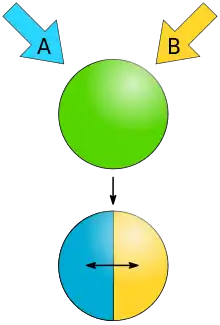Phase separation
Phase separation is the creation of two distinct phases from a single homogeneous mixture.[1] The most common type of phase separation is between two immiscible liquids such as oil and water. Colloids are formed by phase separation, though not all phase separation forms colloids - for example oil and water can form separated layers under gravity rather than remaining as microscopic droplets in suspension.

Mixing of liquids A and B and subsequent phase separation

When mixed, oil and vinegar will phase-separate

A phase diagram for two isotopes of helium, showing at bottom a range of temperatures and ratios at which they will phase-separate.
See also
References
- Nic M, Jirat J, Kosata B (1997). "Phase separation". In McNaught AD, Wilkinson A, Jenkins A (eds.). IUPAC Compendium of Chemical Terminology (the "Gold Book") (2nd ed.). Oxford: Blackwell Scientific Publications. doi:10.1351/goldbook.P04534. ISBN 0-9678550-9-8.
Further reading
- Khabibullaev PK, Saidov A (April 2013). Phase Separation in Soft Matter Physics: Micellar Solutions, Microemulsions, Critical Phenomena. Berlin Heidelberg: Springer. ISBN 978-3-662-09278-1.
This article is issued from Wikipedia. The text is licensed under Creative Commons - Attribution - Sharealike. Additional terms may apply for the media files.